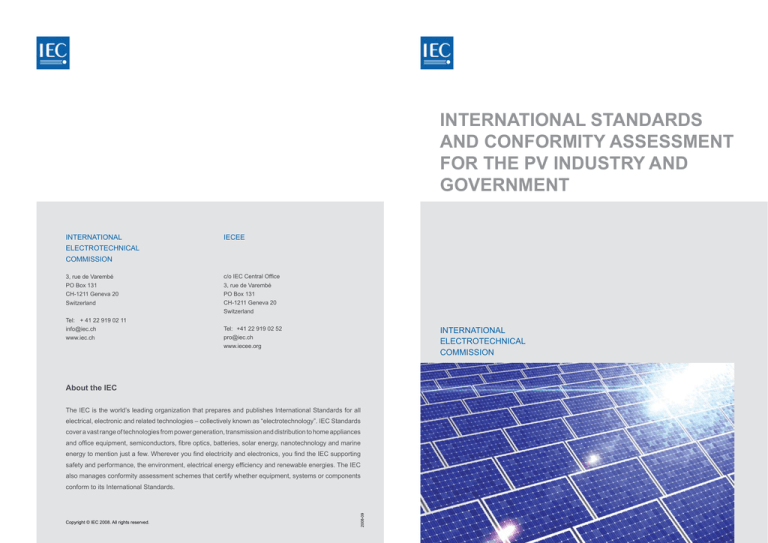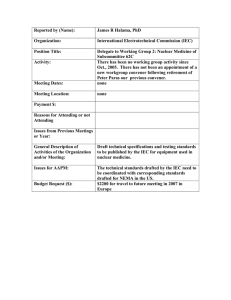
International Standards
and Conformity Assessment
for the PV Industry and
Government
INTERNATIONAL
IECEE
ELECTROTECHNICAL
COMMISSION
3, rue de Varembé
PO Box 131
CH-1211 Geneva 20
Switzerland
Tel: + 41 22 919 02 11
info@iec.ch
www.iec.ch
c/o IEC Central Office
3, rue de Varembé
PO Box 131
CH-1211 Geneva 20
Switzerland
INTERNATIONAL
ELECTROTECHNICAL
COMMISSION
Tel: +41 22 919 02 52
pro@iec.ch
www.iecee.org
About the IEC
The IEC is the world’s leading organization that prepares and publishes International Standards for all
electrical, electronic and related technologies – collectively known as “electrotechnology”. IEC Standards
cover a vast range of technologies from power generation, transmission and distribution to home appliances
and office equipment, semiconductors, fibre optics, batteries, solar energy, nanotechnology and marine
energy to mention just a few. Wherever you find electricity and electronics, you find the IEC supporting
safety and performance, the environment, electrical energy efficiency and renewable energies. The IEC
also manages conformity assessment schemes that certify whether equipment, systems or components
Copyright © IEC 2008. All rights reserved.
2008-09
conform to its International Standards.
International Standards
and Conformity Assessment for
the PV Industry and Government
A global solar potential
International Standards by the world’s
leading experts
The market for PV (photovoltaic) power applications
n New technology storage systems.
The worldwide PV community, including national and
n Applications with special site conditions, such as
regional PV industry associations, and supported by
tropical zone, northern latitudes and marine
such international organizations as The World Bank
areas.
and the United Nations Development Programme,
is expanding rapidly in developed and developing
PV systems convert solar energy into electrical
countries alike. Cumulative installed generating
energy. IEC TC (Technical Committee) 82 prepares
n Recommendations for small renewable energy
decided to institute a high-priority program to offer
capacity in selected countries grew by 36 % in
International Standards for all elements of those
and hybrid systems for rural electrification,
a truly global quality assurance solution. In order
2006, according to the International Energy Agency.
systems – everything from the light inputs to a
including PV systems.
to achieve this goal and to guide the PV industry,
Total PV cell production in 2006 was reported to be
PV cell to the interface with the systems to which the
about 1 900 megawatts, an increase of 27 % from
electrical energy is supplied.
especially in developing countries, PV GAP – a notIn addition, IEC TC 82 is addressing the safety of grid-
for-profit international organization dedicated to the
connected systems on buildings and utility-connected
sustained growth of global PV markets to meet energy
Comprised of leading industrial and governmental
inverters, as well as the protection of people and the
needs – decided in 2008 to transfer ownership of the
experts from 40 countries, IEC TC 82 has prepared
environment from such things as radiofrequency and
PV GAP Mark and Seal to the IECEE.
As its uses have multiplied and the industry has
International Standards for terms and symbols,
electromagnetic pollution and the toxic materials that
grown, PV has proved to be one of the most reliable
PV module testing, design qualification and type
need to be disposed of during PV manufacturing
With the support of the World Bank, the IECEE is
sources of electricity. Indeed, PV modules now come
approval of crystalline silicon and thin-film modules
processes.
the exclusive issuer of the PV GAP Mark and the
with long-term warranties. But these promises of
and
durability and reliability raise questions about the
systems, among other elements.
2005. Global demand for PV exceeds USD 5 billion
annually.
characteristic
parameters
of
stand-alone
quality of PV components, systems, installations and
after-sales maintenance among customers.
PV GAP Seal. Together with the IECEE International
Conformity Assessment to serve industry
and government
PV Certificate and Test Report, the Mark is the
worldwide reference for manufacturers and suppliers of
monocrystalline silicon terrestrial photovoltaic modules
IEC TC 82’s current work includes:
and PV components used in PV systems to show
The IEC’s International Standards for PV and its
Worldwide System for Conformity Testing and
Certification of Electrotechnical Equipment and
compliance with safety and performance standards.
n System commissioning, maintenance and disposal.
n Characterization and measurement of such
The IECEE provides testing and certification to show
proof of compliance with the IEC’s International
For further information on the IECEE PV Certification,
Components (IECEE) provide both benchmarks and
new-thin film photovoltaic module technologies
Standards for PVs (photovoltaics). Industry and
please contact: Pierre de Ruvo, Executive Secretary,
proofs of quality for industry and government.
as CdTe, CIS, CuInSe2, etc.
governments use the voluntary globally-recognized
IECEE. Email: pro@iec.ch. Web: www.iecee.org.
certification to help assure quality and improve
safety.
The IECEE PV Certificate grants a “PV Quality
Mark”
to
PV
components
that
have
been
designed, manufactured and tested according to
IEC International Standards, and a “ PV Quality Seal”
which covers the conformity of the PV systems as
a whole.
International Standards
and Conformity Assessment for
the PV Industry and Government
A global solar potential
International Standards by the world’s
leading experts
The market for PV (photovoltaic) power applications
n New technology storage systems.
The worldwide PV community, including national and
n Applications with special site conditions, such as
regional PV industry associations, and supported by
tropical zone, northern latitudes and marine
such international organizations as The World Bank
areas.
and the United Nations Development Programme,
is expanding rapidly in developed and developing
PV systems convert solar energy into electrical
countries alike. Cumulative installed generating
energy. IEC TC (Technical Committee) 82 prepares
n Recommendations for small renewable energy
decided to institute a high-priority program to offer
capacity in selected countries grew by 36 % in
International Standards for all elements of those
and hybrid systems for rural electrification,
a truly global quality assurance solution. In order
2006, according to the International Energy Agency.
systems – everything from the light inputs to a
including PV systems.
to achieve this goal and to guide the PV industry,
Total PV cell production in 2006 was reported to be
PV cell to the interface with the systems to which the
about 1 900 megawatts, an increase of 27 % from
electrical energy is supplied.
especially in developing countries, PV GAP – a notIn addition, IEC TC 82 is addressing the safety of grid-
for-profit international organization dedicated to the
connected systems on buildings and utility-connected
sustained growth of global PV markets to meet energy
Comprised of leading industrial and governmental
inverters, as well as the protection of people and the
needs – decided in 2008 to transfer ownership of the
experts from 40 countries, IEC TC 82 has prepared
environment from such things as radiofrequency and
PV GAP Mark and Seal to the IECEE.
As its uses have multiplied and the industry has
International Standards for terms and symbols,
electromagnetic pollution and the toxic materials that
grown, PV has proved to be one of the most reliable
PV module testing, design qualification and type
need to be disposed of during PV manufacturing
With the support of the World Bank, the IECEE is
sources of electricity. Indeed, PV modules now come
approval of crystalline silicon and thin-film modules
processes.
the exclusive issuer of the PV GAP Mark and the
with long-term warranties. But these promises of
and
durability and reliability raise questions about the
systems, among other elements.
2005. Global demand for PV exceeds USD 5 billion
annually.
characteristic
parameters
of
stand-alone
quality of PV components, systems, installations and
after-sales maintenance among customers.
PV GAP Seal. Together with the IECEE International
Conformity Assessment to serve industry
and government
PV Certificate and Test Report, the Mark is the
worldwide reference for manufacturers and suppliers of
monocrystalline silicon terrestrial photovoltaic modules
IEC TC 82’s current work includes:
and PV components used in PV systems to show
The IEC’s International Standards for PV and its
Worldwide System for Conformity Testing and
Certification of Electrotechnical Equipment and
compliance with safety and performance standards.
n System commissioning, maintenance and disposal.
n Characterization and measurement of such
The IECEE provides testing and certification to show
proof of compliance with the IEC’s International
For further information on the IECEE PV Certification,
Components (IECEE) provide both benchmarks and
new-thin film photovoltaic module technologies
Standards for PVs (photovoltaics). Industry and
please contact: Pierre de Ruvo, Executive Secretary,
proofs of quality for industry and government.
as CdTe, CIS, CuInSe2, etc.
governments use the voluntary globally-recognized
IECEE. Email: pro@iec.ch. Web: www.iecee.org.
certification to help assure quality and improve
safety.
The IECEE PV Certificate grants a “PV Quality
Mark”
to
PV
components
that
have
been
designed, manufactured and tested according to
IEC International Standards, and a “ PV Quality Seal”
which covers the conformity of the PV systems as
a whole.
International Standards
and Conformity Assessment
for the PV Industry and
Government
INTERNATIONAL
IECEE
ELECTROTECHNICAL
COMMISSION
3, rue de Varembé
PO Box 131
CH-1211 Geneva 20
Switzerland
Tel: + 41 22 919 02 11
info@iec.ch
www.iec.ch
c/o IEC Central Office
3, rue de Varembé
PO Box 131
CH-1211 Geneva 20
Switzerland
INTERNATIONAL
ELECTROTECHNICAL
COMMISSION
Tel: +41 22 919 02 52
pro@iec.ch
www.iecee.org
About the IEC
The IEC is the world’s leading organization that prepares and publishes International Standards for all
electrical, electronic and related technologies – collectively known as “electrotechnology”. IEC Standards
cover a vast range of technologies from power generation, transmission and distribution to home appliances
and office equipment, semiconductors, fibre optics, batteries, solar energy, nanotechnology and marine
energy to mention just a few. Wherever you find electricity and electronics, you find the IEC supporting
safety and performance, the environment, electrical energy efficiency and renewable energies. The IEC
also manages conformity assessment schemes that certify whether equipment, systems or components
Copyright © IEC 2008. All rights reserved.
2008-09
conform to its International Standards.



